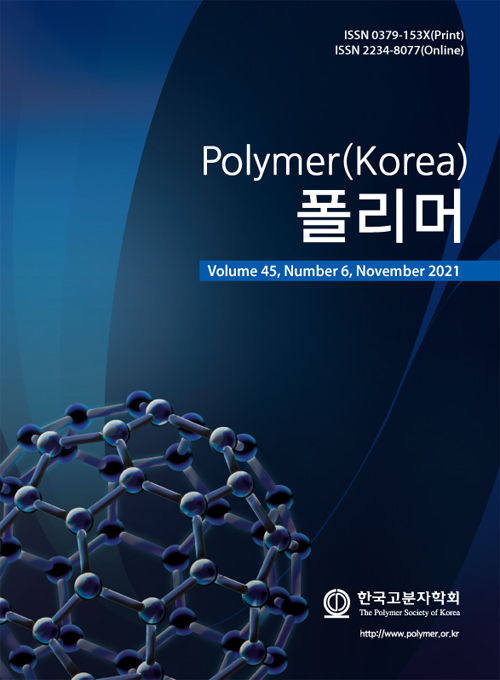- Energy Storage Performance of Carbon Nanofiber Electrodes Derived from Crosslinked PI/PVDF Blends
School of Advanced Materials and Chemical Engineering, Daegu Catholic University, Gyeongsan, Gyeongbuk 38430, Korea
- 가교한 PI/PVDF 블렌드로부터 유도된 탄소 나노섬유 전극의 에너지 저장 특성
대구가톨릭대학교 신소재화학공학과
Reproduction, stored in a retrieval system, or transmitted in any form of any part of this publication is permitted only by written permission from the Polymer Society of Korea.
Supercapacitor stores energy through the interfacial contact of ions between electrodes and electrolytes; thus, the surface area and porosity of electrode materials are critical to determining the energy performance of the supercapacitor. Carbon nanofibers (CNFs) have been widely investigated as supercapacitor electrodes, which are generally synthesized by thermal treatment of electrospun precursor polymer nanofibers. In this study, the energy storage performance of CNFs was improved by modifying the chemical structures of precursor polymers. A blend of aromatic polyimide (PI) and polyvinylidene fluoride (PVDF) was chosen as a precursor and it was crosslinked before thermal treatment to improve the surface properties. Electrochemical properties were measured by assembling coin cells, and CNF electrodes derived from crosslinked PI/PVDF exhibited a specific capacitance of 322 F/g (10 mV/s) and energy density of 11.6 Wh/kg (0.5 A/g), which showed significantly higher energy storage properties than those of non-crosslinked one.
슈퍼커패시터는 전극과 전해질 계면의 이온 접촉으로 에너지를 저장하기 때문에 전극의 표면적과 다공성이 에너지 저장 특성을 결정하는 주요 요인이다. 전극 물질로 탄소 나노섬유(CNF)가 많이 연구되고 있는데, 주로 전구체 고분자를 전기방사하고 열 처리하여 합성한다. 본 연구에서는 전구체 고분자의 화학 구조 조절을 통하여 탄소 나노섬유의 에너지 저장 특성을 개선하였다. 방향족 폴리이미드(PI)와 폴리비닐리덴 플루오라이드(PVDF) 블렌드를 전구체로 사용하였고, 열처리 전 가교 처리를 하여 표면 특성을 개선하였다. 코인 셀을 조립하여 전기화학적 특성을 평가한 결과, 가교한 PI/PVDF로 합성한 CNF전극의 비정전용량이 322 F/g(10 mV/s), 에너지 밀도가 11.6 Wh/kg(0.5 A/g)로 가교를 하지 않은 전극 대비 높은 에너지 저장 특성을 보였다.
Keywords: supercapacitors, carbon nanofibers, crosslinking, polyimide, polyvinylidene fluoride.
- Polymer(Korea) 폴리머
- Frequency : Bimonthly(odd)
ISSN 0379-153X(Print)
ISSN 2234-8077(Online)
Abbr. Polym. Korea - 2023 Impact Factor : 0.4
- Indexed in SCIE
 This Article
This Article
-
2021; 45(6): 927-933
Published online Nov 25, 2021
- 10.7317/pk.2021.45.6.927
- Received on Jul 22, 2021
- Revised on Sep 6, 2021
- Accepted on Sep 10, 2021
 Correspondence to
Correspondence to
- Kyung-Hye Jung
-
School of Advanced Materials and Chemical Engineering, Daegu Catholic University, Gyeongsan, Gyeongbuk 38430, Korea
- E-mail: khjung@cu.ac.kr










 Copyright(c) The Polymer Society of Korea. All right reserved.
Copyright(c) The Polymer Society of Korea. All right reserved.